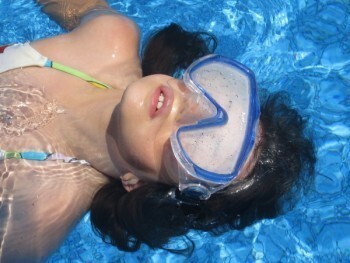It hurts all of us to see our children in pain or discomfort – especially when it is a result of something he or she loves to do, like swimming.
Swimmer’s ear is a condition that is more common in children than in any other age group. According to the Centers for Disease Control and Prevention, swimmer’s ear results in an estimated 2.4 million visits to the doctor a year.
What Is Swimmer’s Ear?
The medical name for swimmer’s ear is “otitis externa”–an infection and inflammation that develops on the ear canal. Its symptoms are not always immediate, but usually develop within a few days of water recreation. Symptoms of swimmer’s ear include redness, swelling and itching of the ear. Infected ears can experience pain when pressure is applied.
Parents sometimes think that swimmer’s ear and a middle ear infection are interchangeable terms. That isn’t so. If no pain or discomfort is present on the outside of the ear, the problem most likely is not swimmer’s ear.
Causes and Treatment
First, swimmer’s ear is not contagious – it cannot be passed between people in your backyard pool or the neighborhood one. So don’t worry about continuing to get the most use out of your pool.
The condition develops from water or other debris (sand, dirt, etc.) being in the ear canal for long periods of time. Germs can thrive in this wet environment, infecting the ear canal and skin.
Though often painful for children, swimmer’s ear is a fairly easy condition to treat, usually remedied with ear drops.
Prevent Swimmer’s Ear
The best treatment is always prevention, and swimmer’s ear is not quite impossible to avoid. The key to reducing the risk of swimmer’s ear is keeping ears dry and clean.
Wearing earplugs will prevent water from entering the ear canal when swimming laps, or when submergence of the head will be frequent (perhaps during swimming lessons). After swimming, be sure to dry ears well, tilting each ear to the ground, allowing any water to leave the canal. If that isn’t enough, pull the ear lobes in different directions to help water escape. If water still feels present, use a hair dryer (on the lowest heat setting) to help dry out the ear canal.
A clean, chemically balanced pool will definitely deter swimmer’s ear, as germs will are less likely to spread. When on vacation or visiting a public pool, feel free to ask how often the levels are checked – an unbalanced pH level will make chlorine and other disinfectants less effective.
For your backyard swimming pool, take the same precautions. Shock it when appropriate, and keep chemical levels balanced. Fortunately, Kayak Pools Midwest’s three-way filtration system constantly circulates pool water, a process that helps purify and clean at all times.
If your child is developing symptoms of swimmer’s ear, consult your family’s physician before taking action on your own. The infection will have them out of the water for at least a week, so heed the precautions and don’t miss out on any summer fun!

